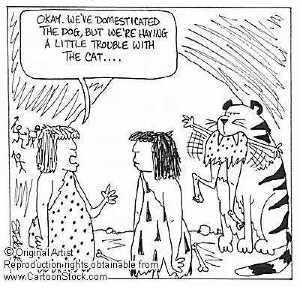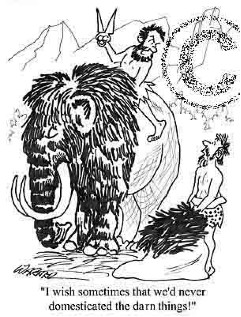Tameability and Domestication
Bio 342 By Alex Winters
Mechanism
When were the first animals domesticated?
 While there is some debate about
the first instance of
domestication, it is generally accepted that it has been going on for
about 13, 000, with dogs being one of the first domesticated animals.
(Although there is some evidence, that bee keeping was around before
that.) In the next approximately 5,000 years, four of the
“big
five” were domesticated as well. (Chua 2006).
While there is some debate about
the first instance of
domestication, it is generally accepted that it has been going on for
about 13, 000, with dogs being one of the first domesticated animals.
(Although there is some evidence, that bee keeping was around before
that.) In the next approximately 5,000 years, four of the
“big
five” were domesticated as well. (Chua 2006).
Where were the first animals domesticated?
It probably occurred first
in
what are now China and the Middle East. Records of the first
domesticated (horses) date back to about 6,00 years ago.
(Chua 2006).
How were the first animals domesticated?
Exact methods of early animal domestication are also disputed and may have been different for different animal and human populations.
- One idea is that animals (especially dogs) may have found it advantageous to follow hunter-gatherer bands in order to secure more protection and to feed on the waste and scraps left by those peoples. Animals that could better predict humans’ movements and could use human social cues to find food would be selected for.
- Alternatively, especially in the cases of cows and sheep that were used primarily for agricultural purposes, early farmers and herders may have exerted more control over the selection by actively choosing more tame animals and breeding them.
- Others believe that the argument between artificial and natural selection is irrelevant, as there is no reason to believe that the two were mutually exclusive. In fact, it is likely that the two worked together or sequentially in many animal populations. (Saetre et al 2006; Parker & Ostrander 2005).
How did animal domestication change human society?
In many ways, one could argue that animal and plant domestication lead to human society as it is today. When human societies began to transition fro hunter-gather to farming (and began taming animals for work and food) many changes occurred in the typical life cycle.
How did domestication cause these changes?
Many
historians say that the biggest difference between groups that
successfully transitioned to farming societies was the availability of
species that could be tamed. 
- Populations grew enormously as births no longer had to be spaced to allow for only one small child per adult female, as was necessary when bands were constantly moving and small children had to be carried.
- The farming lifestyle led to a much larger food production and the ability to store food during winter. This excess food capability meant that some members of society could devote time to invention and create the printing press, allowing dissemination of information and leading to modern society.
- Pack animals also were used as war animals, enabling new tactics and greater loss of life.
- The well-fed upper classes who had time to devote to inventing and forming nations also had the opportunity to create armies and start wars.
- The types of illnesses that have killed the most people in the modern world are all so-called “crowd diseases” that could not have formed before the transition to farming. (Diamond 2002).